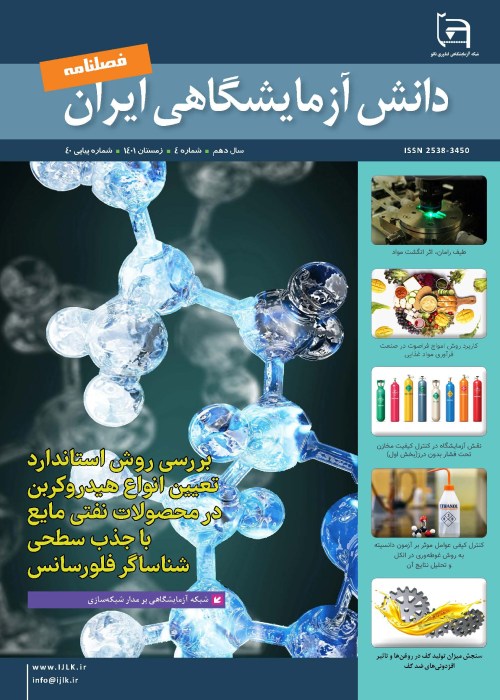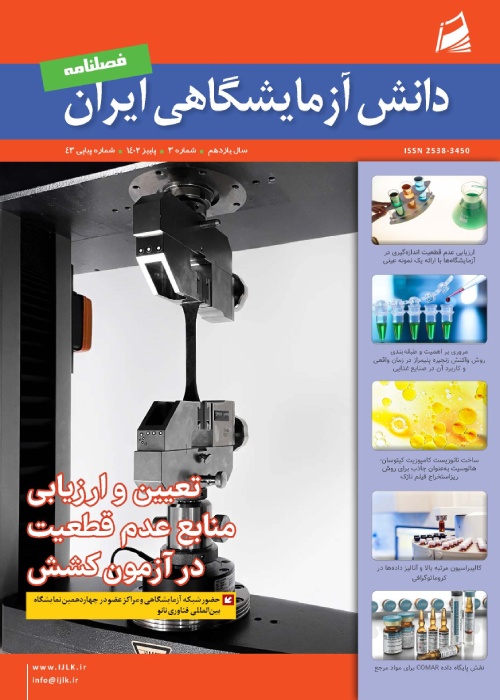فهرست مطالب

مجله دانش آزمایشگاهی ایران
سال دهم شماره 4 (پیاپی 40، زمستان 1401)
- تاریخ انتشار: 1402/01/15
- تعداد عناوین: 9
-
صفحات 2-5
- استاندارد
- مقالات
-
صفحات 7-11
-
صفحات 12-21
-
صفحات 22-36
-
صفحات 53-58
-
Pages 7-11
Today, spectroscopic methods have attracted the attention of many researchers and industrialists for the identification and characterization of materials due to their many advantages over other analysis methods. Raman spectroscopy is one of the types of vibrational spectroscopy methods that are used in many fields such as biology, medicine, identification of drugs, petrology, 2D materials, semiconductors, protein materials, food, etc. Raman spectroscopy is a widely used, fast, accurate, and non-destructive method. Raman spectra contain valuable information about the molecular structure of materials. Raman microspectrophotometers, in addition to recording the Raman spectra of the micrometric points of the samples, can provide transmission and reflection imaging of the desired points.
Keywords: Microspectrophotometer, Raman spectroscopy, Carbon-based materials, Graphene, Nanocomposite, Blood -
Pages 12-21
One of the modern techniques used in ultrasound is composed of sound waves with frequency beyond the limit of human hearing. Ultrasound techniques are relatively cheap, simple and energy saving. Low-intensity ultrasound is a non-destructive technique that provides information about physicochemical properties, such as composition, structure, physical state and flow rate. High-intensity ultrasound is used to alter, either physically or chemically, the properties of foods, for example to generate emulsions, disrupt cells, promote chemical reactions, inactivation microorganisms, tenderize meat and modify crystallization processes. Ultrasonic waves at high intensity alone can destroy the cell walls of microbes but when it is combined with a rapid thermal process for sterilizing foods to improve. Ultrasonic processing is still in its infancy and requires a great deal of future research in order to develop the technology on an industrial scale, and to more fully elucidate the effect of ultrasound on the properties of foods.
Keywords: Ultrasound, Extraction, Processing, Food, Microbial inactivation -
Pages 22-36
The purpose of this article is to explain the role of the laboratory in the quality control of seamless cylinders. First, in this article, the types, property, applications of compressed natural gas cylinders are discussed. Then the methods and processes of the production of these cylinders are reviewed. Afterwards, national and international standards, product approvals and tests that performed on gas cylinders are considered. Mechanical properties and Material tests, Destructive and Non-destructive tests are reviewed. At the result, can ensure reliability and desired quality of the CNG cylinders for the defined usage
Keywords: Laboratory, Seamless Gas Cylinders, Compressed Natural Gas (CNG), Materialtests, Mechanical properties tests, Destructivetest, Non-destructive tests -
Pages 37-41
Polymers typically have a "specific" density that can provide an approximation of the density of a particular material. However, various factors can affect the density, such as crystallinity, loss of softener or solvent absorption. Components of the same sample may also vary in density due to differences in crystallinity, thermal history, porosity, or changes in material composition, such as the addition of a filler or pigment. The variety of properties of most engineering polymers causes differences in their applications. This can cause variety in density of polymers. In fact, many polymers are identified and classified by this important factor. Like all tests, this test also has uncertainties, and in this article, an attempt has been made to describe the important factors that cause errors and uncertainties in this test method
Keywords: density test, quality control, density by alcohol immersionmethod, error, uncertainty measurement -
Pages 42-47
Foaming on oil has a very undesirable effect which can cause an increase in oxidation by intensive mixture with air, damage to cavitation, and insufficient oil transportation in the lubrication circulation system which can cause poor lubrication. Adding the appropriate antifoam additives is one way to avoid foaming. To determine the tendency of foaming formation which has an impact on the stability of the performance of lubricating oil, so that there is wear and tear in research in the laboratory by means of; 6 types of lubricating oil taken from the market are tested for viscosity, index viscosity, flash point, pour point and color. As well as to determine the effect of foam formation tested foaming tendency / stability and wear before and after antifoam added from 6 (six) types of lubricated oil obtained from the market. The result after adding antifoam additives, three types (GB, SH, and MH) of six types of lubricated oil were tested, the tendency of foaming and the wear results met the required limits, namely 0/50/0 ml for foaming tendency and maximum 0.5 mm for wear, while for 3 (three) oils, the results are not satisfying the required limits.
Keywords: foaming, antifoam polydimethylsiloxane, wear -
Pages 48-52
Petroleum hydrocarbons which include aromatic, olefinic and saturated compounds are in the group of usual environment polluting compounds. These polluting compounds can come to environment from different references such as petroleum leakage from automobiles and planes. Most of these compounds can cause cancer and lead to genetical problems. Therefore, recognition of them by cheap standard methods to control the quality of produced fuels is very important. Here we have Used sample adsorption from silica gel in a capillary column and separating different components based of affinity to adsorb on silica gel by volume percent
Keywords: Hydrocarbon, petroleum products, olefin, aromatic, saturated, fluorescent indicator, capillary adsorption colum


